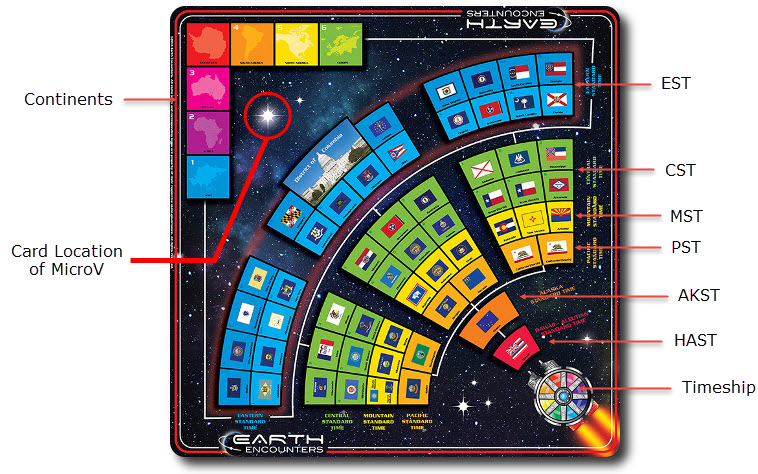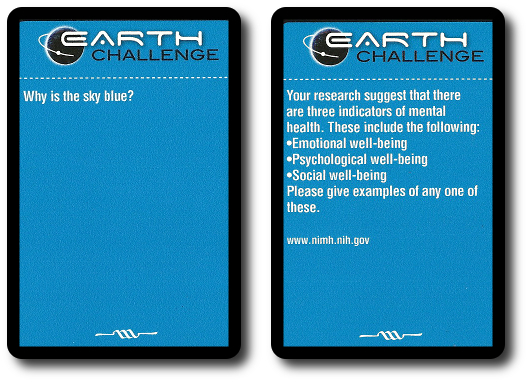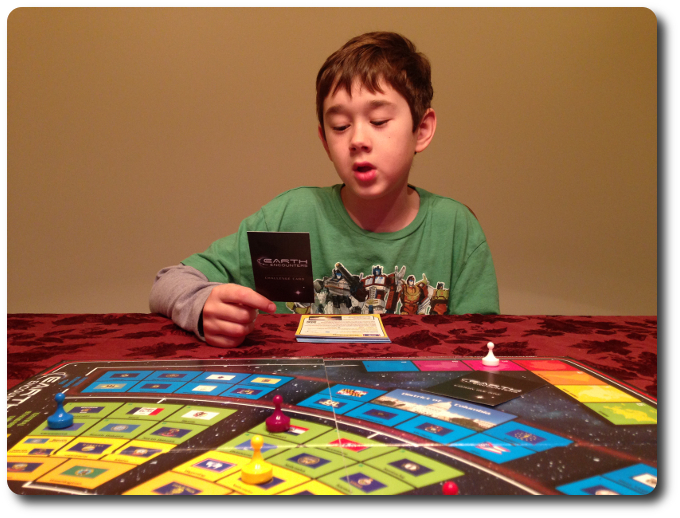Please Take Note: This is a review of the final game, but it might change slightly based on the success of the Kickstarter campaign. The game is being reviewed on the components and the rules provided with the understanding that “what you see is not what you might get” when the game is published. If you like what you read and want to learn more, we encourage you to visit the game publisher’s website or visit the Kickstarter campaign. Now that we have all that disclaimer junk out of the way, on with the review.

The Basics:
- For ages 12 and up (publisher suggests “Teen to Adult”)
- For 2 to 6 players (or teams)
- Approximately 60 minutes to complete
Geek Skills:
- Active Listening & Communication
- Counting & Math
- Logical & Critical Decision Making
- Reading
- Cooperative & Team Play
- Self-confidence
- Imagination
Learning Curve:
- Child – Easy
- Adult – Easy
Theme & Narrative:
- Save Earth through the power of knowledge!
Endorsements:
- Gamer Geek rejected!
- Parent Geek approved!
- Child Geek rejected!
Overview
Regardless of the counter-measures and fail-safes put in place, the MicroV has escaped. This deadly alien life form is invisible, intelligent, and will do anything to survive. Records show that a ship was stolen and is headed towards a remote planet in the Milky Way known as “Earth” by its inhabitants. You are being sent to find, capture, and return MicroV before it devours all life on Earth. But to do that, you will need the help of the earthlings. You must prove to them your superior intellect before they will take you seriously.
Earth Encounters, a self-published game designed by father and son team Lawrence and Taylor Walker, will reportedly be comprised of 1 game board, 65 Deeds of Trust cards, 200 Challenge cards, 150 Q & A cards, 22 Eastern Standard Time Zone cards, 6 player/team pawns, and 1 standard six-sided die. As this is a review of a prepublished game, I will not comment on the game component quality.
Approaching Earth
To set up the game, first unfold and place the game board in the middle of the playing area. Now is an excellent opportunity to very briefly go over the game board, as its use is not intuitive. The Timeship is the starting location. Players will move through different time zones (all abbreviated in the image example) and work their way up to the Eastern Standard Time Zone (EST) where the endgame awaits. Each state is represented in their respective time zone, as well as 7 continents. The bright solitary star hanging ominously above Washing D.C. is where a random card is drawn and placed. This card identifies where the MicroV is secretly hidden. The white line that originates from the Timeship and travels through several time zones, making its way to the continents serves as a “path” that the players take to different locations.

Second, place every player/team pawn being used on the Timeship. This is the starting space(ship). In this game, players can work together as a team or play against each other as individuals. Regardless of how many people are playing, only 1 pawn per team or player is allowed. Any not used should be returned to the game box.
Third, shuffle the Q & A and Challenge cards into 2 different piles. Place the two piles to one side of the game board. These will be the Q & A and Challenge draw piles for the duration of the game.
Fourth, collect all the Deeds of Trust cards and place them in a pile to one side of the game board. There is no need to shuffle this pile of cards.
Sixth, shuffle the Eastern Standard Time Zone (EST) cards and deal 1 card, face-down, to the star above Washington D.C. This card will remain in this position for the majority of the game and will only be revealed when players are ready to encounter the MicroV. Place the rest of the EST cards to one side of the game playing area, face-down.
Seventh, have each player or 1 player per team roll the six-sided die. The player with the highest roll goes first.
That’s it for game set up. Time to save Earth.
Building Trust and Searching for the Mother of All Alien Monsters
Earth Encounters is played in turns with no set number of turns per game. On a player’s or team’s turn, they will do the following.
Step 1: Roll Die
To advance in the game, players must roll a certain number on the six-sided die. The number to be rolled is determined by the time zone or location the player/team pawn is attempting to move into. For example, to move to the Hawaii/Aleutian Standard Time Zone (HAST), an even number must be rolled. However, if the player/team pawn is currently located in the Central Standard Time Zone (CST), the number rolled corresponds to a state location which has a small number on it.
If a player/team is located in HAST or Pacific Standard Time Zone (PST), they can attempt to answer a question from a Q & A card if they didn’t roll a number that allowed them to advance. If they answer the question correctly, they may roll the die again. This can be repeated until the player/team advances or they guess incorrectly.
Step 2: Attempt Advance
Now that the player/team knows where they will be going, they must decide how they will earn the trust of the earthlings that live there. This is done by demonstrating to the earthlings your great wisdom or through persuasive speech.
The Q & A cards represent the player’s/team’s attempt to win the earthlings over through wisdom. Each Q & A card has 3 question types. These are Interrogative, Multiple Choice, and True or False. The player/team does not get to decide the question type. That is left up to luck. The six-sided die is rolled and the number value is matched to either an Interrogative, Multiple Choice, or True and False question. The question is ready out loud to the player/team by an opponent, but no one but the player/team can answer it. The answers are on the back of the card.

The Challenge cards represent the player’s/team’s attempt to win the earthlings over through persuasive speech. A Challenge card is drawn and read out loud by an opponent. The Challenge cards will either ask a simple 1 sentence question or a complex one with multiple layers of information before the question is even asked. The point to this challenge is not to necessarily get the answer right, as some of them questions can only be answered subjectively. Instead, the goal is to convince the other players in the game that you know what you are talking about, or at the very least, an educated opinion.

If the player/team answers the Q & A question correctly, they advance to the new location on the game board by moving their pawn. The same goes for being given a pass by the other players in the game for the Challenge card. It should be noted that the Q & A card answers are up to debate, but cannot be argued. Whatever is listed on the card is the required answer. The same cannot be said for the Challenge cards. Expect opponents to debate if the player/team should be given the Challenge card.
Step 3: Collect Deed of Trust
If the player/team is the first to advance to a new state or continent, the Deed of Trust for that location is found and presented to the player/team. The Deed of Trust card should remain face-up in front of the player/team. These cards are necessary for the endgame and are packed with interesting bits of information about the state or continent they represent.

Example Deed of Trust
This completest the player’s/team’s turn. The next player/team in turn order sequence now goes.
Entering the East
All the states in the EST are under a force field created by the MicroV. The only way through this protective shell is a small hole directly above Washington D.C. To gain access to Washington D.C., a player must travel to 1 of the 7 continents from the Central Standard Time Zone (CST). It’s a roundabout way to get there, but the MicroV won’t be able to see the player coming.
Once the player/team is in the EST, they go about advancing and earning Deeds of Trust as normal, except players lose Deeds of Trust if they don’t complete Challenge or Q & A cards correctly. After all the EST Deeds of Trust cards have been collected, the EST card above Washington D.C. can be revealed by any player. The player/team holding the Deed of Trust card that matches the EST card is the winner of the game.

Maybe.
If another player/team has more Deeds of Trust than the player/team who just won, they may challenge them in what is referred to as “sudden death”, where no one actually dies. Instead, players/teams will now take turns attempting to answer Q & A cards. Answering questions correctly earns Deeds of Trust. Answering them incorrectly will force the player/team to lose them. If the player/team is out of Deeds of Trust, they are exiled to Antarctica. That’s cold, baby…
If the game goes into “sudden death”, the last player with Deeds of Trust wins.
To learn more about Earth Encounters, visit the game publisher’s website or visit the Kickstarter campaign.
Final Word
The Child Geeks, by and large, did not care for Earth Encounters, which is not surprising. Trivia games are seldom enjoyed by the Child Geeks since it’s impossible for them to win the game by being lucky, strategic, or having better tactics. As one Child Geek put it, “I hate games like this. If you don’t know the answer, you can’t win the game. Why even bother playing it if you know you can’t win?” A valid question. After trying the game with the Child Geeks alone, we put them into teams with Parent Geeks. This greatly improved their feelings towards the game, but not by much. One Child Geek said, “At least I have a chance to win, but I’m not contributing much to my team.” True enough, but when paired with older players, the Child Geeks were able to have fun and worry less. The older Child Geeks, who are by all rights “Teens”, didn’t care much for the game, either. One “Teen” Child Geek said, “I like the questions, but the game isn’t that interesting. Why is all this information on the Deeds of Trust cards, for example? It’s neat, I guess, but doesn’t help me win the game.” When all the votes were gathered and counted, Earth Encounters was rejected by the Child Geeks.

My son was the “Official Reader of Cards” for our team…a catchy title…
The Parent Geeks had a very different point-of-view of the game. One Parent Geek said, “This is a great game. It covers everything. Math, science, the arts, and it has a Sci-Fi theme! That adds a bit of cool.” Another Parent Geek said, “This would be a great game for schools or for a family who home schools. It’s loaded with information that is worth knowing and talking about.” Speaking of the questions, the Parent Geeks really liked how players could either answer questions or attempt to persuade their opponents. As one Parent Geek put it, “That’s brilliant because it not only challenges a player to think about the answer, but it also has them speaking to the other players. This builds confidence, public speaking, and challenges the audience to do some critical listening.” The Parent Geeks liked playing the game with their Child Geeks, too, helping them think about the questions and solving the problems. When the games were over, the Parent Geeks voted to approve Earth Encounters.
The Gamer Geeks were not impressed with Earth Encounters. A few of them even became a bit belligerent. While I will note their passionate dislike of the game, I will not quote their comments. Not to worry, there were many comments provided that I can publish. For example, one Gamer Geek said, “This is a Trivia game, I get that, but I don’t understand why they say it’s about saving Earth. It’s not. The end games collapses into a petty struggle between players.” Another Gamer Geek said, “If we forget about the game’s theme, we are left with a Trivia game that still feels like it’s being worked on. The game board needs to be improved, the rules need to be completely re-written, and they have to fix how the game is won.” All of the Gamer Geeks agreed that the mix of questions and the option to “make your case” (as one Gamer Geek put it) with the Challenge cards was good, but everything else was forgettable. The Gamer Geeks voted to reject Earth Encounters, preferring to never encounter it again.
Trivia games are tricky to design, in my opinion. You have to create a game that will challenge the majority, but not leave the minority out in the cold. But it’s very difficult to not alienate players in either group. Some will find the game too difficult and some will find the game too easy. Others won’t be interested in the game because it lacks any thematic element or any strategic game play. Others will love the fact that the entire game tests a player’s knowledge. There is a thin line between the two, but it’s devilishly difficult to straddle and oftentimes impossible to identify.
I personally found the theme of Earth Encounters to be pasted on, lacking any connection whatsoever to the game play. There is no alien monster to chase down, capture, and destroy. I never felt like I was a superior alien race that had mastered traveling through time and space. The background story for this game does Earth Encounters a grave injustice. It incorrectly positions the game, sets the players up for what should be a big fight with the MicroV, but ultimately doesn’t deliver and comes across as just plain goofy. The epic story and menacing alien life force only exists within the game’s description.
If we put the game’s theme aside, we are left with a project with honorable intentions, but brings nothing new to the table. There are many Trivia games out there that discuss everything from current cultural events and politics to Star Wars. Earth Encounters, sadly, is lost in this sea of monotony. The only aspect of the game that gives Earth Encounters a true advantage and opportunity to rise above the other Trivia games is its theme and narrative. If the game designers would embrace these two elements and use them to reinforce the game play, perhaps players could really feel like they were taking on the roles of alien heroes sent to Earth to save humanity. Using knowledge as ammo in an epic war would be worth getting excited about, would take Trivia games in a bold new direction, and set Earth Encounters high above the rest.
This is a paid for review of the game’s final prototype. Although our time and focus was financially compensated, our words are our own. We’d need at least 10 million dollars before we started saying what other people wanted. Such is the statuesque and legendary integrity of Father Geek which cannot be bought except by those who own their own private islands and small countries.



